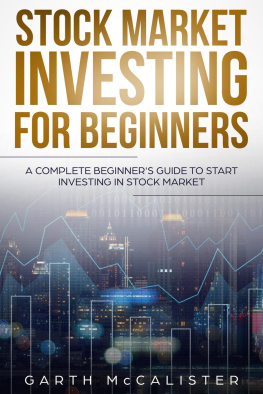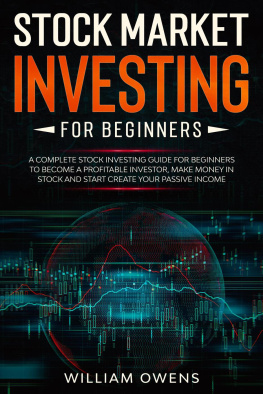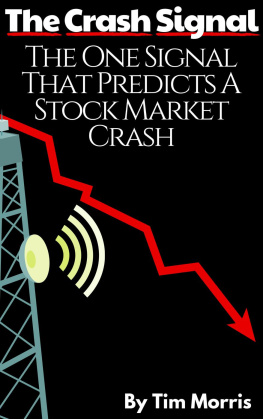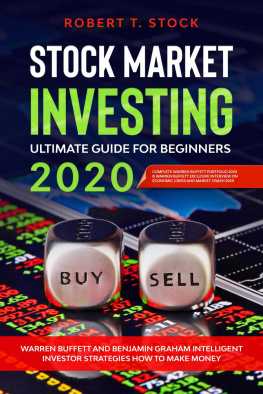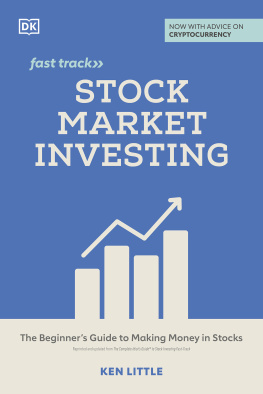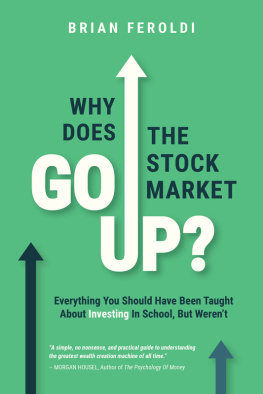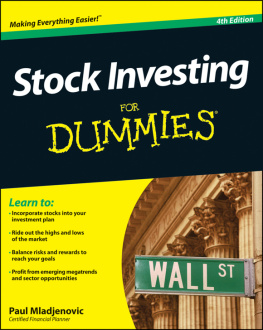Stock Market Investing For Beginners:
THE DEFINITIVE STOCK MARKET CRASH COURSE FROM ZERO TO HERO.
By Warren Ray Benjamin
Table of Contents
Introduction
Financial independence is a goal many of us have, but the outlook is bleak for how to gain it. You can strive to work 40 hours a week, own your home, but have a mortgage to pay, and never gain financial independence until retirement. You may even work more than 40 hours a week by picking up extra shifts, but with a family to raise, paying off your debts is difficult.
The goal is to make the information extremely simple for you, so you can move through with ease and begin investing in a few short months. The topics will take you through a history of the stock market, how it works, and the various exchanges and indexes that allow you to invest in the market.
It is difficult to believe there was a time when the stock market didnt exist. The stock market is on the tip of nearly everyones tongue. Even individuals who do not invest at least know it exists. It is mostly understood that the New York Stock Exchange is the biggest market of them all, with any company listed on it that wants to be recognized globally. However, how did the stock market come to fruition? Is there more than the NYSE (New York Stock Exchange)? There are more exchanges, and it started with the Real Merchants of Venice and British Coffeehouses.
Europe was filled with moneylenders that filled in the gaps of the larger banks. Moneylenders would trade between themselves. One lender might get rid of a high-risk, high-interest loan by trading it to another lender. Moneylenders also purchased government debt. In a natural evolution, lenders started selling debts to customers who were looking to invest.
Investors also put their money into ships and crews. Most of the time-limited liability companies would go on a single voyage to gain merchandise from Asia and the East Indies as a way to bring a profit to the investor. New companies were usually formed for the next voyage to reduce the risk of investing in ships that could end up in disaster. The East India companies worked with investors by providing dividends made from the goods that came in. Stocks were now in place, where the first joint-stock company was created. At the time, there were royal charters that made competition impossible, and thus investors gained huge profits.
It was not without its troubles. The stock market is based on economic stability. When instability reigns, the stock market can crash because there is no liquidity, which is what happened during the Great Depression. Everyone saw the banks failing due to debts and little liquidity, which in turn caused others to suffer, businesses too close, and stock shares to plummet.
The stock market formed from a need to have a place to conduct the business of selling shares, which was already happening. Governments needed to regulate stock sales, and prevent issues like the SSC crash. Nevertheless, there was also greed on behalf of wealthy citizens. There was a clear way to earn money from someone elses labor; thus, the stock exchanges were started.
Investors and traders sell stocks after the IPO based on the perceived value. A companys value can go up or down, which is where investors make their money. A companys stock price that rises can provide a profit. If an investor has purchased those shares and the price or company value decreases, then the investor will lose money. Besides, the investors and traders will push the price in an up or down direction.
Investors have one of two goals: investing in the short or the long term. A long-term investment is based on a stock continuing to rise in price. A short-term investment is to gain quick cash and pulling out before the stock price decreases.
Mature companies offer dividends to their shareholders. If you have stocks, then you are a shareholder in a company. If you hold the stocks long enough and have enough stock in a company, you can vote on new board members. Dividends are company profits that you get a cut of.
Investors will make money on price fluctuations and dividends. A seller is often trying to gain a profit by selling to a new buyer. The new buyer is also trying to buy-in as low as possible so that when the stock price continues to increase, they will make a profit.
The profit is calculated by taking the initial buy-in price and subtracting it from the closing or sale price. For example, if you buy into Google at $400 and wait for it to go up to $600, then the profit is $200 per share.
Sellers can push the price down due to supply and demand. This financial market works based on supply and demand.
You should already know that in economics when there is an oversupply of a product, the price is low. There is no demand for the product; therefore, a company or, in this case, a stock is not of interest.
When there is an undersupply of something like a stock, the demand is high. With more interested parties, a price will continue to increase.
If there is an even amount of supply and demand, then equality exists, and there is no movement to see.
For the stock market, when too many people sell a stock, the price will decline. When too many people buy a stock, the price will continue to rise. If there is an equal number of shares and interests, then the price usually trades sideways because there is a balance.
As you learn about the stock market, you will hear the word volume, often. Volume is the number of shares that change hands daily. Millions of shares can be traded on the stock exchange in a day as investors attempt to make money from increasing or decreasing prices.
The stock market works based on the interest or volume of traders. If a stock does not have any volume or very little, then it is not actively traded; thus, the price is not moving. Traders such as market makers get into the market to buy or sell stocks for companies with low volume. They do not stop a stock from rising or falling. Instead, market makers are just trying to garner interest in the companys stock.
When it comes to the stock market and traders, most individuals are looking for the high volume trades, with fluctuating prices. They get in, make a profit, and get out finding the next big profit.
Chapter 1- Basic Information About Stocks
What Is Stock and What Types of Stock Are Available
People like to throw around the word stock. However, most people dont understand what it means. For the record, lets clarify the meaning of the word so that you understand what youre getting into.
Stock is an ownership stake in a company. When a company issues stock, it divides the ownership into portions called shares. You buy an ownership stake in a company by purchasing shares of stock, so if you purchase shares of Exxon, which means that you are one of the owners of Exxon that entitles you too many things, including a share of the company profits as the fortunes of the company improve, the value of the shares increases because there will be more demand for ownership. If the company experiences bad times, or the economy starts doing badly, investors will start selling off their ownership stakes. That means supply will exceed demand, causing prices to drop. Since owning shares in the company may not be seen as profitable, the prices have to drop to attract new buyers.
Publicly traded companies issue large numbers of shares, and they are traded on regulated public markets called stock exchanges. There are two general classes of stock. These are:
- Common stock: This is what most people are referring to when they use the word stock. A common stock gives you an ownership stake and voting rights in the company. Voting will occasionally take place when shareholders have the opportunity to vote on important company decisions. Shares of common stock entitle the holder to receive dividends. But not all companies pay dividends, as well explain in a moment. Something to keep in mind is that common stockholders are last in line if a company decides to liquidate or declare bankruptcy.









